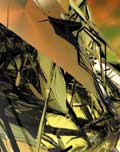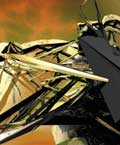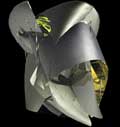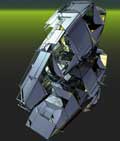Marcos Novak
ZeichenBau : Virtualités réelles
TransVienna
Space is no longer innocent. Under the impact of science and technology, ordinary space has become just a subset of a composite "newspace" that interweaves local, remote, telepresent, interactivated, and virtual spacetime into the new spatial continuum that is the focus of emerging transarchitectures. Physically, this installation consists of four interrelated parts : a) a large scale video projection of liquid forms derived from mathematical explorations of virtuality ; b) a physical model captured from the fluctuating projected virtual forms ; c) a sensor-created, invisible, interactive sculptural form, and ; d) a generative, interactive soundscape that weaves the previous three together. The video projection consists entirely of liquid, animated mathematical forms derived from the manipulation of mathematical fields. Various kinds are shown in rapid succession. An interactive, generative musical algorithm drives the video, intercutting among various sources at a high rate, producing a large number of new variants by multiplexing the sources in time. Each strand of video is thought of as a separate reality, and the rapid intercutting suggests the coexistence of multiple superimposed realities in the same instance. The rapid flickering tests the edge of our temporal perception, while the emergence of forms that are not in the source materials questions our familiar notions of objectivity. The physical component of the installation is a static form derived from the mathematical fields presented in the video portion. Captured from the perpetual flux of virtuality, this form has been built using LOM (laminated object manufacturing), a rapid prototyping process that builds forms directly from computer models by layering thousands of sheets of laser-cut paper. The resulting form has a dual personality : its geometry retains the character of its virtual origins, but its materiality is that of carved and polished wood. It is at once an anticipation of a static architecture derived from virtuality, and a premonition of a built dynamic, liquid architecture in which buildings actually move. The invisible component of the installation is implemented as a sensor field created by an infra-red sensor-and-lens apparatus. The sensor-and-lens creates a distinct shape in space that, although invisible to the human eye, can be monitored and can yield information to the computer. When one reaches into this shape, a stream of numbers reports exactly how far into the shape one extending. This information is, in turn, fed into the musical algorithms that generate the soundscape surrounding the whole piece, altering them. If one pays attention to the sound it is possible to feel, synaesthetically, the shape of the invisible form, reversing all our ordinary expectations of sculpture and architecture. Retinality is replaced by presence and voyeurism is replaced by intimate hypertactility. This piece investigates the axis between perception and materiality, connecting the two with interactivity. It explores the idea of multiple and multiplexed time in a way that tests the limits of temporal perception, and captures a single physical form from the numerous fluctuating virtual ones. The resulting object looks and feels like a heavy carved wood piece, at quite a contrast with both the virtual forms and with the sensorcreated invisible form, that, in turn, acts as an interface to the interactive/generative musical algorithms that drive the virtual forms and create the temporal multiplexing, closing the circle. Both the idea of an invisible architecture/sculpture and the idea of multiplexed time hint at the existence of other realities besides the usual retinal one. The multiplexing of time is particularly cinematic, but in an unprecedented manner : it involves interweaving numerous segments of film or animation under algorithmic control as fast as possible, in a way that allows the viewer not only to see several "films" at once, but also to begin to see sequences that do not exist in the original materials and are simply fabricated by perception. The word "films" is in quotes because, in it's fullest form, the separate strands would not be filmed or animated but would be computed in realtime, driven by algorithms and controlled by sensors. The investigation of multiple time is also the natural extension of my ongoing explorations of fields, non-Euclidean and trans-Euclidean spaces, and the derivation of architecture based on four-or-more spatial dimensions. The aspects of this installation that are here presented as nearly separate components, will in subsequent installations be brought closer and closer together, until they cannot be distinguished one from the other. New realities require new vocabularies. I have coined the terms liquid architectures, transarchitectures, eversion, transmodernity, and others to begin to articulate the new conditions that we encounter on our journey to virtuality. In this sense, the overall work is an instance of transarchitectures ; the phenomena it explores belong to the idea of "eversion," the casting out of the virtual onto the actual, a concept that is the natural complement to the idea of "immersion" ; and the work is offered as an artifact of the cultural outlook of transmodernity.
Marcos Novak









